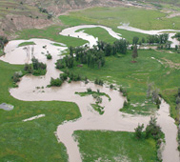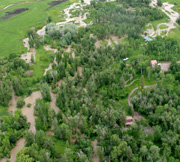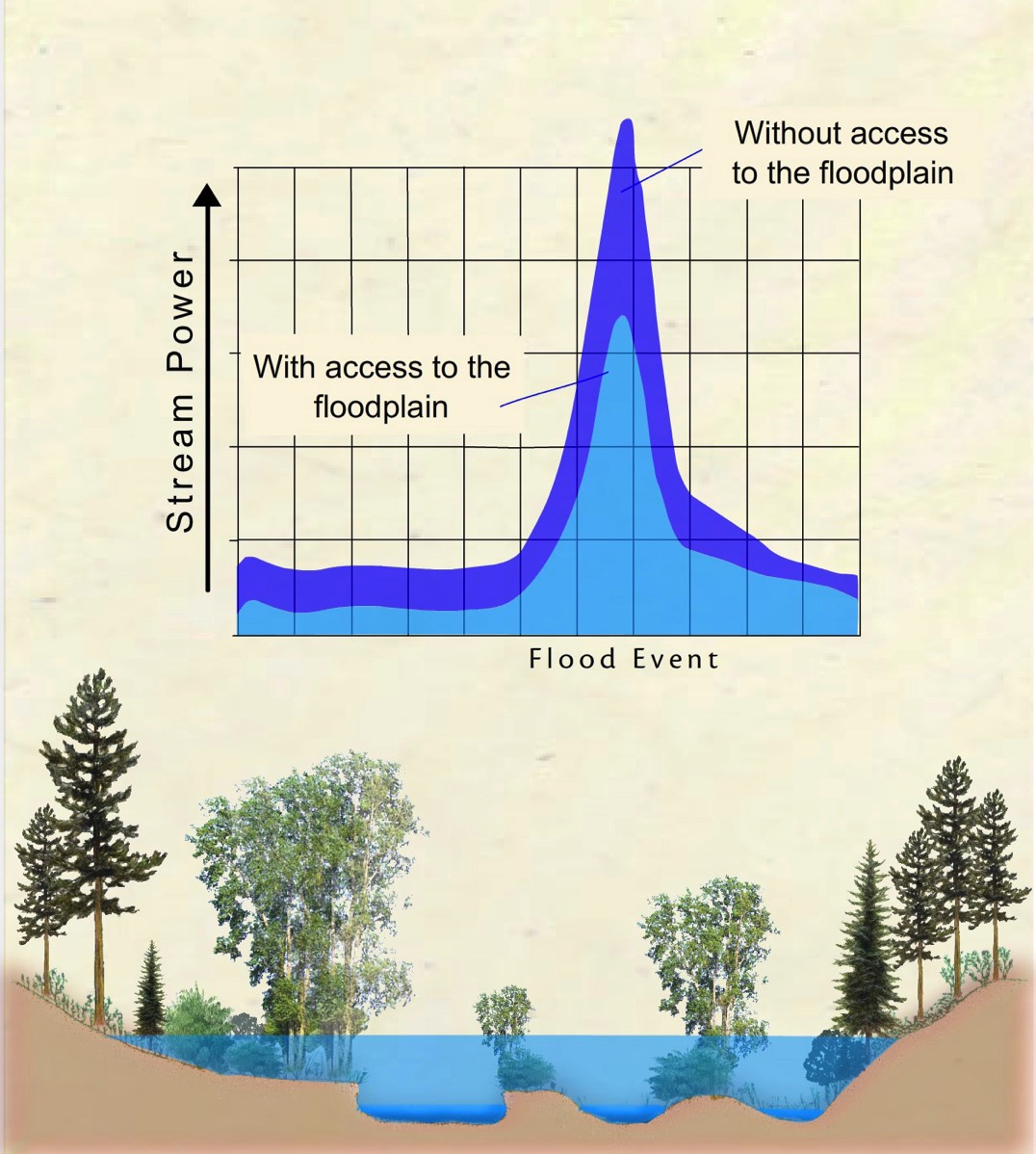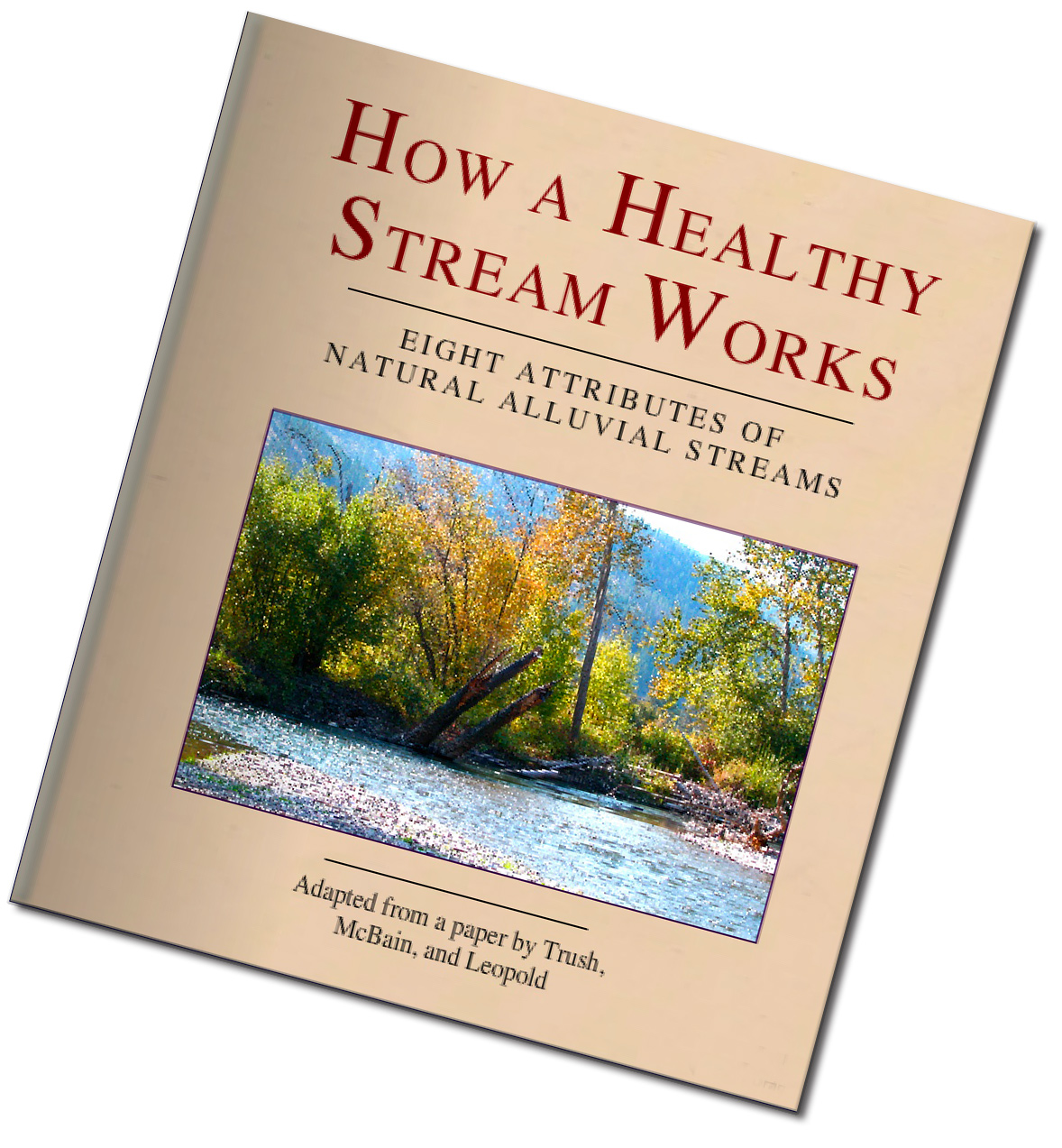Hydrology: Attributes of a Healthy Stream
An alluvial stream is one whose channel is composed of the sediments transported by the stream itself and that generally changes the shape of its bed as the rate of flow changes. (Adapted from Attributes of an alluvial river and their relation to water policy and management by Trash, McBain, and Leopold).

Attribute Six (Part B): : Floodplains Reduce Stream Power During Floods
Undeveloped, vegetated floodplains reduce the force of floodwaters by allowing them to spread out horizontally and relatively harmlessly across a relatively rough floodplain surface. Some of that roughness comes from living, decaying, and dead vegetation that provides numerous barriers against moving water. Adding to the roughness is floodplain topography, which includes lots of rises and depressions that also slow the flow of water so it is not delivered downstream as quickly or with as much force.
The conversion of streamside forests to agricultural land for grazing or crop production harms the floodplain's ability to reduce the force of floodwaters. Removing streamside forests also results in an increase in soil compaction and a reduction in soil porosity. All these impacts combine to cause a significant decrease in infiltration and a corresponding increase in the speed and amount of flood runoff, which means an increase in flooding and storm damage downstream and greater risk of serious damage to the stream itself as well as lives and property.


Floodplain flooding reduces stream power and damage

Hydrology: Attributes of a Healthy Stream
An alluvial stream is one whose channel is composed of the sediments transported by the stream itself and that generally changes the shape of its bed as the rate of flow changes. (Adapted from Attributes of an alluvial river and their relation to water policy and management by Trash, McBain, and Leopold).

Attribute Six (Part B): : Floodplains Reduce Stream Power During Floods
Undeveloped, vegetated floodplains reduce the force of floodwaters by allowing them to spread out horizontally and relatively harmlessly across a relatively rough floodplain surface. Some of that roughness comes from living, decaying, and dead vegetation that provides numerous barriers against moving water. Adding to the roughness is floodplain topography, which includes lots of rises and depressions that also slow the flow of water so it is not delivered downstream as quickly or with as much force.
The conversion of streamside forests to agricultural land for grazing or crop production harms the floodplain's ability to reduce the force of floodwaters. Removing streamside forests also results in an increase in soil compaction and a reduction in soil porosity. All these impacts combine to cause a significant decrease in infiltration and a corresponding increase in the speed and amount of flood runoff, which means an increase in flooding and storm damage downstream and greater risk of serious damage to the stream itself as well as lives and property.
Floodplain flooding reduces stream power and damage



Hydrology: Attributes of a Healthy Stream
An alluvial stream is one whose channel is composed of the sediments transported by the stream itself and that generally changes the shape of its bed as the rate of flow changes. (Adapted from Attributes of an alluvial river and their relation to water policy and management by Trash, McBain, and Leopold).
Attribute Six (Part B): : Floodplains Reduce Stream Power During Floods
Undeveloped, vegetated floodplains reduce the force of floodwaters by allowing them to spread out horizontally and relatively harmlessly across a relatively rough floodplain surface. Some of that roughness comes from living, decaying, and dead vegetation that provides numerous barriers against moving water. Adding to the roughness is floodplain topography, which includes lots of rises and depressions that also slow the flow of water so it is not delivered downstream as quickly or with as much force.
The conversion of streamside forests to agricultural land for grazing or crop production harms the floodplain's ability to reduce the force of floodwaters. Removing streamside forests also results in an increase in soil compaction and a reduction in soil porosity. All these impacts combine to cause a significant decrease in infiltration and a corresponding increase in the speed and amount of flood runoff, which means an increase in flooding and storm damage downstream and greater risk of serious damage to the stream itself as well as lives and property.


Floodplain flooding reduces stream power and damage
